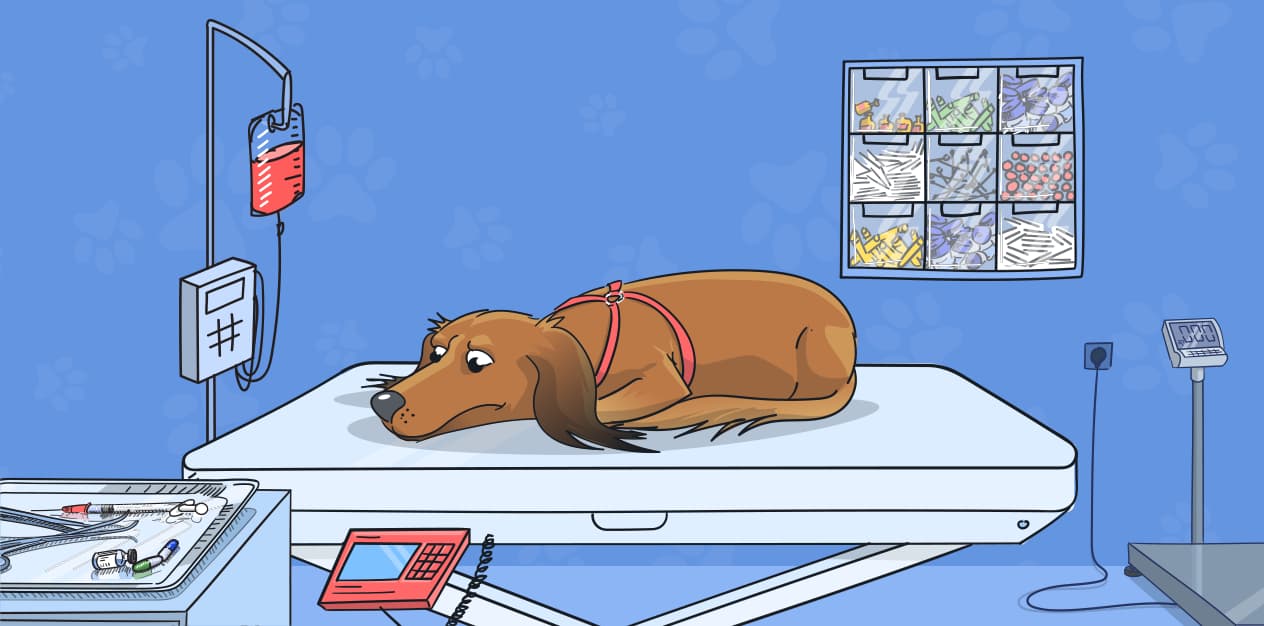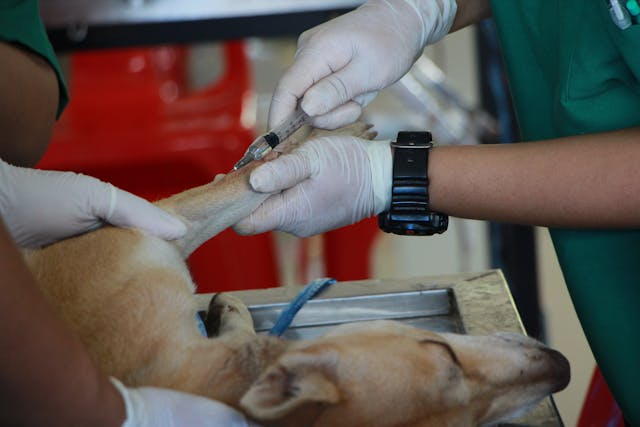

The Whole Bloody Truth About Pet Blood Transfusions
Learn all about which dog or cat health issues require a blood transfusion, different blood types in pets and how transfusions work for your furry friends.

Writer Jannah Berkley
7 min read

Many people don’t realize that blood transfusions can help our beloved pets just like they help humans. Despite this fact, animal blood transfusions actually aren’t new. They’ve been happening for centuries all over the world.
Blood transfusions are usually needed in emergency situations, like severe bleeding after an accident or for diseases that attack red blood cells (RBCs). They are commonly used to treat anemia, but can also be used to treat blood clotting disorders.
So how does it work? Does the procedure vary between cats and dogs? Why would your pet even need a transfusion to begin with? Keep reading to learn all about this potentially life saving treatment.
All about dog blood types
There have been more than 12 blood types identified in dogs, but a few in particular must be paid attention to when it comes to a blood transfusion. The more common blood groups start with DEA which stands for Dog Erythrocyte Antigen. DEA 1.1 and DEA 1.2 are considered the most clinically significant blood types, and dogs can only be positive for one or the other. In most veterinary hospitals around the world, they only test for DEA 1 positivity and no other blood types. When your dog gets tested, the clinic can tell you if they’re DEA 1 positive or negative.
Dogs don’t have naturally occurring antibodies to DEA 1, so it’s widely accepted that a dog’s first blood transfusion doesn’t have to be crossmatched. Still, it’s good practice to do so anyway. Subsequent transfusions are always crossmatched, as once a dog has been exposed to DEA 1 they’ll develop antibodies to it, and then can only receive DEA 1 negative blood.
Other blood antigens, including DEA 3, 4, 5 and 6, don’t produce as severe of a reaction regardless of if the patient has antibodies or not. As a result, these aren’t routinely tested for.
Be aware, though – there’s a difference in who can give and receive blood safely depending on whether they’re positive or negative.
A dog who’s DEA 1 negative can NOT receive positive transfusions.
A dog who’s DEA 1 positive CAN receive either positive or negative blood.
All about cat blood types
There are three blood types found in cats: A, B, and AB. In the U.S., almost 99% of cats are Type A. Fewer have Type B, and type AB is even rarer than that.
Cats have natural antibodies to the blood type they don’t have. In other words, type A felines are born with B antibodies and Type B felines are born with A antibodies. Therefore, cats can only receive their own blood type, so there are no universal feline donors like there are when humans are involved. That being said, AB cats do not have antibodies to either A or B, so they’re a universal recipient. Since cats have natural antibodies at birth, they’re always typed and crossmatched before a transfusion.
How pet blood donations work
Some pet hospitals have “colonies”, which are in-house donors they can draw blood from when needed. These animals get adopted out after a certain amount of time. These “colony” animals are treated very well in some hospitals, but animal welfare groups have protested this arrangement due to the perceived harm to their quality of life.
Pet blood banks are definitely a thing that exists, but responsible pet parents should keep in mind that they frequently experience high demands and blood shortages, so they’re not always an available source. Some pet hospitals have client pets donate blood. They don’t get paid, but they do often get perks like free exams and parasite prevention. Some clinics will also give donors a special treat or toy.
In order to be a donor, your pet needs to be completely healthy, young, and of a big enough size for the donation to not adversely affect them. Cats usually give less than two ounces of blood per donation, whereas dogs usually give around a pint per donation.
Chances of success
The first and most important thing with blood transfusions is making sure that your pet’s blood and the donor blood are compatible. There’s a test called crossmatching that’s performed prior to a transfusion. The donor blood is tested with a sample of your pet’s blood to make sure there’s no antibody reaction. The donor blood should also be screened before being given to your pet to make sure it’s clear of any infectious diseases.
Based on clinical evaluation, with the right donor blood and a full compatibility screening, blood transfusions are generally well tolerated and effective in helping anemic animals.
Do understand, though, that the success of a transfusion is largely dependent on your pet’s underlying disease, performance of blood typing and crossmatching, and appropriate monitoring during the transfusion.
Also note that no vet will ever take an owner’s word for what their pet’s blood type is – they’ll always be typed and crossmatched. But it is important to let your vet know if your pet has had a prior transfusion.
Risks and side effects
There are two kinds of adverse reactions to blood transfusions – immunologic reactions and non-immunologic reactions.
Immunologic reactions have to do with the recipient’s immune response to receiving foreign red blood cells. It can act similar to an allergic reaction. A non-immunologic reaction, on the other hand, isn’t caused by the immune system but rather by the donated blood itself, whether due to damage to the RBCs in the donor sample prior to or during transfusion, or due to things like volume overload, leading to strain on the heart.
Another adverse scenario would involve a patient being transmitted a disease via the blood from the donor. Fortunately, this is extremely rare due to required donor screening protocols put in place to prevent this very issue.
Some potential side effects in pets receiving a blood transfusion include a decrease in blood calcium levels, hives, fever, and vomiting. There’s also a higher chance of side effects in dogs who’ve had a previous transfusion. They may develop delayed destruction of donor red blood cells, but delayed reactions are typically more mild than acute ones. Acute reactions occur within about 4 hours of transfusion and if they’re spotted, the transfusion must be stopped, as this means there’s blood incompatibility. A new donor sample must be used for continued transfusion.
For cats, the most serious risk is hemolysis (destruction of red blood cells). This happens rarely in house cats. Still, if cats receive too much blood, they could get fluid buildup in their lungs. Other minor, and relatively rare, side effects are the same as dogs’ – including decreased calcium, vomiting, fever or hives.

Let’s talk costs
Many pets only need one transfusion, as once they’re stabilized, the underlying cause can be addressed. But there are other costs associated with a transfusion, including pre-transfusion testing, such as a physical exam, bloodwork, and radiographs to find the underlying disease causing the anemia and to evaluate the severity of it.
A blood transfusion is often accompanied by a period of intense hospitalization, and medication or surgery to address the underlying cause. Pets may require regular monitoring of RBC concentration until normalized. Some pet owners have spent upwards of $1,400 just for a blood transfusion. More generally, though, the average range is between $500 and $2,000. With a few days of hospitalization, one or more blood transfusions, and supportive care, veterinary bills can skyrocket up to nearly $4,000-$6,000.
It’s important to be educated on the symptoms of anemia so veterinary care can be pursued early in a disease process. Monitor your pet for extreme lethargy and weakness, sudden collapse or paleness. If any of these symptoms are noted, it should prompt a veterinary visit. Having pet insurance in place from when your pet is adopted is a great way to have a safety net when it comes to the financial aspect of unexpected veterinary visits.
Blood transfusions are a complex – and expensive – issue, but they can be literal life savers. That’s precisely the reason you want someone to have your back when the chips are down. That’s where Animalia’s dog insurance comes into the picture – blood transfusions, among many other things, are included in our first rate coverage.





We offer the most
comprehensive coverage
out there
car with a spare tire for life’s bumps.
Having Animalia is like a pimped-out
Rolls Royce with a swimming pool
in the trunk.



Get your pet insurance quote
Pet type
- Dog
- Cat




